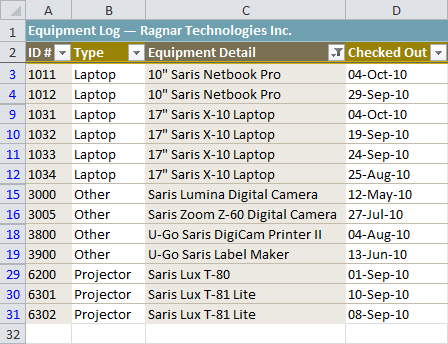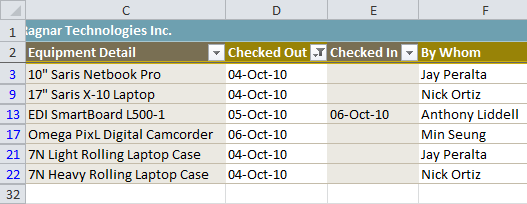Introduction

In this lesson, you'll learn how to filter the data in your worksheet to display only the information you need.
Filtering data
Video: Filtering Data in Excel 2010
Optional: You can download this example for extra practice.
To filter data:
In this example, we'll filter the contents of an equipment log at a technology company. We'll display only the laptops and projectors that are available for checkout.- Begin with a worksheet that identifies each column using a header row.

- Select the Data tab, then locate the Sort & Filter group.
- Click the Filter command.

- Drop-down arrows will appear in the header of each column.
- Click the drop-down arrow for the column you want to filter. In this example, we'll filter the Type column to view only certain types of equipment.

- The Filter menu appears.
- Uncheck the boxes next to the data you don't want to view, or uncheck the box next to Select All to quickly uncheck all.
- Check
the boxes next to the data you do want to view. In this example, we'll
check Laptop and Projector to view only these types of equipment.

- Click OK. All other data will be filtered, or temporarily hidden. Only laptops and projectors will be visible.

Filtering options can also be found on the Home tab, condensed into the Sort & Filter command.
To add another filter:
Filters are additive, meaning you can use as many as you need to narrow your results. In this example, we'll work with a spreadsheet that has already been filtered to display only laptops and projectors. Now we'll display only laptops and projectors that were checked out during the month of August.- Click the drop-down arrow where you want to add a filter. In this example, we'll add a filter to the Checked Out column to view information by date.
- Uncheck the boxes next to the data you don't want to view. Check the boxes next to the data you do want to view. In this example, we'll check the box next to August.

- Click OK. In addition to the original filter, the new filter will be applied. The worksheet will be narrowed down even further.

To clear a filter:
- Click the drop-down arrow in the column from which you want to clear the filter.
- Choose Clear Filter From.

- The filter will be cleared from the column. The data that was previously hidden will be on display once again.
To instantly clear all filters from your worksheet, click the Filter command on the Data tab.
Advanced filtering
To filter using search:
Searching for data is a convenient alternative to checking or unchecking data from the list. You can search for data that contains an exact phrase, number, date, or simple fragment. For example, searching for the exact phrase Saris X-10 Laptop will display only Saris X-10 laptops. Searching for the word Saris, however, will display Saris X-10 laptops and any other Saris equipment, including projectors and digital cameras.- From the Data tab, click the Filter command.
- Click the drop-down arrow in the column you want to filter. In this example, we'll filter the Equipment Detail column to view only a specific brand.
- Enter the data you want to view in the Search box. We'll enter the word Saris to find all Saris brand equipment. The search results will appear automatically.

- Check the boxes next to the data you want to display. We'll display all of the data that includes the brand name Saris.
- Click OK. The worksheet will be filtered according to your search term.

Using advanced text filters
Advanced text filters can be used to display more specific information, such as cells that contain a certain number of characters or data that does not contain a word you specify. In this example, we'll use advanced text filters to hide any equipment that is related to cameras, including digital cameras and camcorders.- From the Data tab, click the Filter command.
- Click the drop-down arrow in the column of text you want to filter. In this example, we'll filter the Equipment Detail column to view only certain types of equipment.
- Choose Text Filters to open the advanced filtering menu.
- Choose a filter. In this example, we will choose Does Not Contain to view data that does not contain the text we specify.

- The Custom AutoFilter dialog box appears.
- Enter your text to the right of your filter. In this example, we'll enter cam to view data that does not contain these letters. That will exclude any equipment related to cameras, such as digital cameras, camcorders, camera bags, and the digicam printer.

- Click OK. The data will be filtered according to the filter you chose and the text you specified.
Using advanced date filters
Advanced date filters can be used to view information from a certain time period, such as last year, next quarter, or between two dates. Excel automatically knows your current date and time, making this tool easy to use. In this example, we'll use advanced date filters to view only the equipment that has been checked out this week.- From the Data tab, click the Filter command.
- Click the drop-down arrow in the column of dates you want to filter. In this example, we'll filter the Checked Out column to view only a certain range of dates.
- Choose Date Filters to open the advanced filtering menu.
- Click a filter. We'll choose This Week to view equipment that has been checked out this week.

- The worksheet will be filtered according to the date filter you chose.

If
you're working along with the example file, your results will be
different from the images above. If you want, you can change some of the
dates so the filter will give more results.
Using advanced number filters
Advanced number filters allow you to manipulate numbered data in different ways. For example, in a worksheet of exam grades you could display the top and bottom numbers to view the highest and lowest scores. In this example, we'll display only certain types of equipment based on the range of ID #s that have been assigned to them.- From the Data tab, click the Filter command.
- Click the drop-down arrow in the column of numbers you want to filter. In this example, we'll filter the ID # column to view only a certain range of ID #s.
- Choose Number Filters to open the advanced filtering menu.
- Choose a filter. In this example, we'll choose Between to view ID #s between the numbers we specify.

- Enter a number to
the right of each filter. In this example, we'll view ID #s greater
than or equal to 3000 but less than or equal to 4000. This will display
ID #s in the 3000-4000 range.

- Click OK. The data will be filtered according to the filter you chose and the numbers you specified.

Challenge!
- Open an existing Excel 2010 workbook. If you want, you can use this example.
- Filter a column of data. If you are using the example, filter the Type column so it displays only laptops and other equipment.
- Add another filter by searching for the data you want. If you are using the example, search for EDI brand equipment in the Item Description column.
- Clear both filters.
- Use an advanced text filter to view data that does not contain a certain word or phrase. If you are using the example, display data that does not contain the word cam. This should exclude any camera-related equipment, such as digital cameras and camcorders.
- Use an advanced date filter to view data from a certain time period. If you are using the example, display only the equipment that was checked out in September 2010.
- Use an advanced number filter to view numbers less than a certain amount. If you are using the example, display all ID #s less than 3000.













0 comments:
Post a Comment